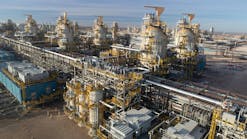The potential of natural gas to reshape energy markets should exert parallel influence on corporate strategies, speakers said at the RMI Oilfield Breakfast Forum in Houston.
Current and prospective gas supply is leaping from development of unconventional resources, especially shales, noted Doug Pferdehirt, president of the Schlumberger Reservoir Production Group.
While the US and Canada dominate current activity, shale gas development is "very much in the early stages of growth in most countries," Pferdehirt pointed out.
He cited a Schlumberger study that found 680 shales in 142 basins and identified 48 basins with shales outside the US as "high-graded" for gas potential.
Of the high-graded basins with shale potential, 32 have existing conventional oil and gas development and therefore equipment and services needed to support shale plays.
Those basins represent "huge potential" for shale gas development, Pferdehirt said.
North American shale plays, meanwhile, have not nearly run their course. A large inventory of North American shale gas wells that have been producing for more than 10 years offers "huge potential for reentry, redrilling, and refracing," he said.
Another speaker, T. Don Stacy, retired chairman and president of Amoco Eurasia Petroleum Co., encouraged companies to emphasize natural gas as "an ideal stop-gap energy source" that is "least environmentally harmful."
He also said companies should focus on technologies that improve recovery through reservoir optimization and characterization, that cut emissions of greenhouse gases, and that reduce costs over the full life cycle of activities.
A third tactic Stacy suggested is to enhance or establish presence in member-countries of the Organization of Petroleum of Exporting Countries, which he pointed out represents 74% of global oil reserves but only 45% of current production.
US gas emphasis
An emphasis on unconventional gas is evident in the US exploratory strategy of Anadarko Petroleum Corp., which Frank J. Patterson, vice-president, international exploration, said concentrates on finding "the next big resource play.
Outside the US, however, Anadarko's exploration targets "predominantly oil, predominantly really big," Patterson said.
The company dedicates 45% of its capital budget to maintaining its production base, 20% to megaprojects, 25% to exploration, and 10% to midstream and other work.
At a time of tight capital markets, Patterson said, "if you're not financially disciplined, you're not here anymore."
Terry Newendorp, chairman and chief executive officer of international financial firm Taylor-DeJongh, highlighted challenges of raising capital for oil and gas projects.
In credit markets, he said, "It's a very tough time out there unless you're one of the supermajors."
And the equity market "for smaller companies has disappeared."
A growing option for raising capital, Newendorp said, is the formation of joint ventures. He cited ventures Chesapeake Energy Corp. has entered with Statoil for work in the Marcellus shale, BP America in the Fayetteville shale, and Plains Exploration & Production in the Haynesville shale.
Similarly, he said, North American operators needing capital can form joint ventures with overseas investors that want to enter the region "but need a name to invest in." Such investors, he said, can open new markets for operators and have money.
More Oil & Gas Journal Current Issue Articles
More Oil & Gas Journal Archives Issue Articles

